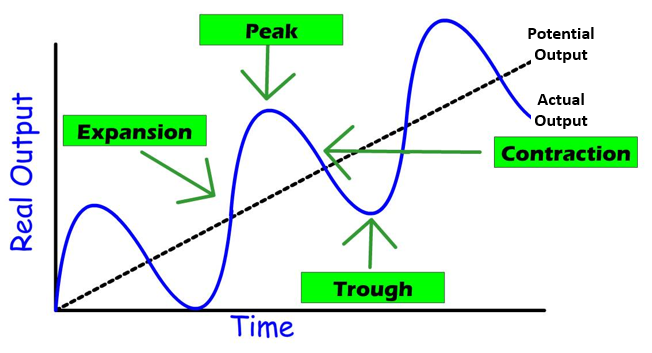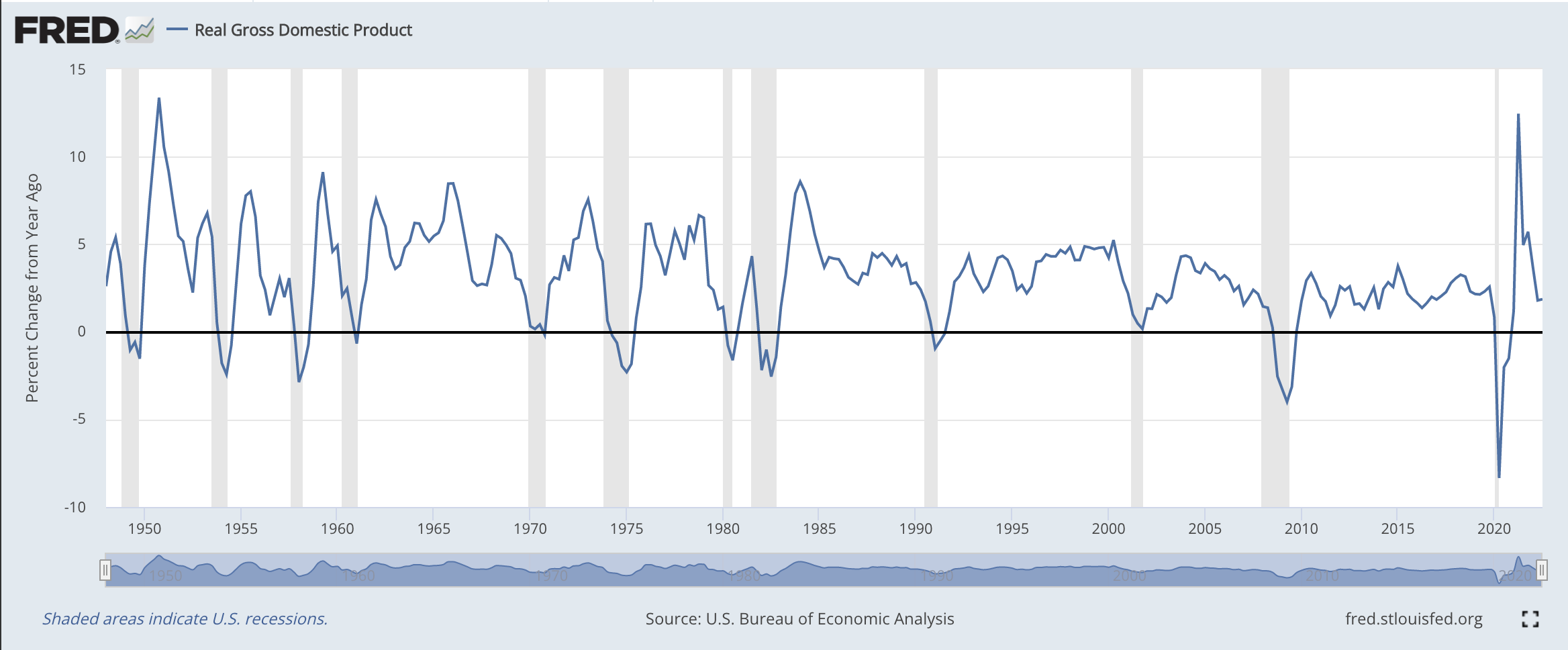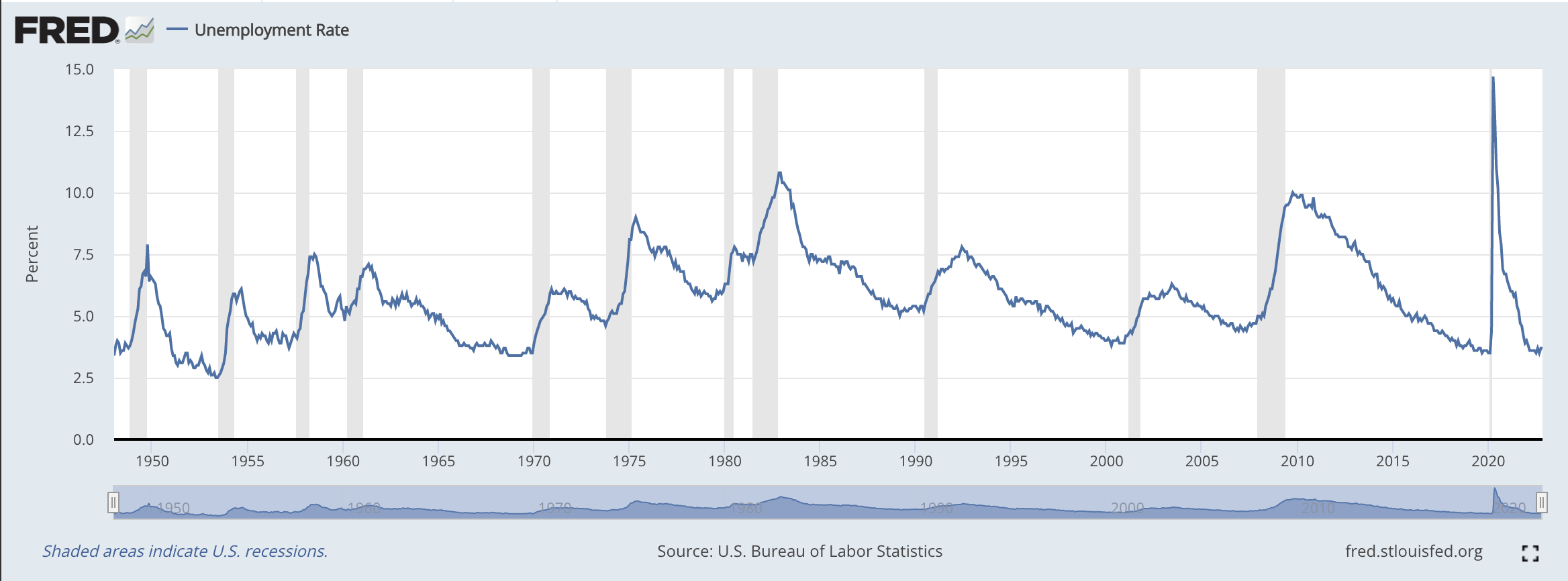
2.7 Business Cycles
3 min read•december 19, 2022
Jeanne Stansak
Jeanne Stansak
Measuring Change in the Economy
In unit 2, we've looked at a few major measures of economic activity. Most notably, we discussed Gross Domestic Product, , and . However, we haven't looked at how we actually use these measures in tandem with each other over time to understand where the economy is and what its health is. As we'll discuss in this guide, the economy is cyclical, meaning that fluctuations in economic measures cycle over time. The cyclical pattern of expansion and of the economy over time is called the .
The Parts of the Business Cycle
The can be viewed by graphing real GDP, a measure of productivity, over time:

Let's break down what each of the pieces of one period of the are:
Expansion Peak
The starts with an expansionary phase, where the economy is growing in the short run. During this phase, is typically very low and is rising. This expansionary phase may also be known as an , because of the positive gap between actual output and potential, long-run equilibrium output. The growth trend line represents the natural rate of real GDP growth over time that the economy hopes to maintain. It also represents a natural and healthy rate of over time. At the growth trend line, the economy is experiencing full employment and meeting each of its goals which include promoting , preventing , and limiting (keeping prices stable). Eventually, the growth slows until the economy reaches a peak.
Contraction Trough
After the economy peaks, it begins contracting. A contractionary period is a period in which the economy is shrinking. This is accompanied with high and low . A is defined as a period of two straight fiscal quarters (6 months) of negative GDP growth. A can develop into a , which is a particularly severe and long . For example, a typical may see hover between 7-9%, the Great saw rates of upwards of 25%. Eventually, the economy reaches a and begins expanding again.
The Business Cycle in Real Life
While we've discussed the in a theoretical sense, we can also observe business cycles in real life data. Take a look at this graph of real GDP growth over time in the United States.

Source: FRED (Federal Reserve Economic Data)
In this graph, the grey areas are recessions. As you can see, the economy is relatively cyclical, but the time between recessions is more variable. Here's a similar graph of the rate over time:

This graph similarly shows the cyclical nature of the economy. In recessions, rises, and steadily decreases in expansionary phases.
Key Terms to Review (10)
Business cycle
: The business cycle refers to the fluctuations in economic activity that occur over time, including periods of expansion (economic growth) and contraction (recession).Contractionary Period
: A contractionary period refers to a phase in the business cycle when there is a decline in economic activity, resulting in reduced production levels, lower employment rates, and decreased consumer spending.Depression
: Depression refers to a severe and prolonged economic downturn characterized by high unemployment, low production, and a decline in overall economic activity. It is often marked by falling prices, reduced consumer spending, and business failures.Economic Growth
: Economic growth refers to an increase in an economy's production capacity over time, resulting in higher levels of real GDP (gross domestic product). It is typically measured by the annual percentage change in real GDP.Gross Domestic Product (GDP)
: Gross Domestic Product (GDP) measures the total value of all final goods and services produced within a country's borders during a specific period (usually annually). It serves as an indicator of economic growth or contraction.Inflation
: Inflation refers to the sustained increase in the general price level of goods and services in an economy over a period of time. It means that, on average, prices are rising and the purchasing power of money is decreasing.Inflationary Gap
: An inflationary gap occurs when the actual level of output in an economy exceeds its potential level, leading to rising prices and increased inflation.Recession
: A recession is an extended period (usually two consecutive quarters) of significant decline in economic activity. It is marked by reduced production levels, increased unemployment rates, and decreased consumer spending.Trough
: The trough is the lowest point in a business cycle, representing the end of a period of economic contraction and the beginning of an expansion. It marks the bottom of a recession or depression.Unemployment
: Unemployment refers to the state of being without a job, actively seeking employment, and available to work. It is an important economic indicator that measures the percentage of the labor force that is jobless.2.7 Business Cycles
3 min read•december 19, 2022
Jeanne Stansak
Jeanne Stansak
Measuring Change in the Economy
In unit 2, we've looked at a few major measures of economic activity. Most notably, we discussed Gross Domestic Product, , and . However, we haven't looked at how we actually use these measures in tandem with each other over time to understand where the economy is and what its health is. As we'll discuss in this guide, the economy is cyclical, meaning that fluctuations in economic measures cycle over time. The cyclical pattern of expansion and of the economy over time is called the .
The Parts of the Business Cycle
The can be viewed by graphing real GDP, a measure of productivity, over time:

Let's break down what each of the pieces of one period of the are:
Expansion Peak
The starts with an expansionary phase, where the economy is growing in the short run. During this phase, is typically very low and is rising. This expansionary phase may also be known as an , because of the positive gap between actual output and potential, long-run equilibrium output. The growth trend line represents the natural rate of real GDP growth over time that the economy hopes to maintain. It also represents a natural and healthy rate of over time. At the growth trend line, the economy is experiencing full employment and meeting each of its goals which include promoting , preventing , and limiting (keeping prices stable). Eventually, the growth slows until the economy reaches a peak.
Contraction Trough
After the economy peaks, it begins contracting. A contractionary period is a period in which the economy is shrinking. This is accompanied with high and low . A is defined as a period of two straight fiscal quarters (6 months) of negative GDP growth. A can develop into a , which is a particularly severe and long . For example, a typical may see hover between 7-9%, the Great saw rates of upwards of 25%. Eventually, the economy reaches a and begins expanding again.
The Business Cycle in Real Life
While we've discussed the in a theoretical sense, we can also observe business cycles in real life data. Take a look at this graph of real GDP growth over time in the United States.

Source: FRED (Federal Reserve Economic Data)
In this graph, the grey areas are recessions. As you can see, the economy is relatively cyclical, but the time between recessions is more variable. Here's a similar graph of the rate over time:

This graph similarly shows the cyclical nature of the economy. In recessions, rises, and steadily decreases in expansionary phases.
Key Terms to Review (10)
Business cycle
: The business cycle refers to the fluctuations in economic activity that occur over time, including periods of expansion (economic growth) and contraction (recession).Contractionary Period
: A contractionary period refers to a phase in the business cycle when there is a decline in economic activity, resulting in reduced production levels, lower employment rates, and decreased consumer spending.Depression
: Depression refers to a severe and prolonged economic downturn characterized by high unemployment, low production, and a decline in overall economic activity. It is often marked by falling prices, reduced consumer spending, and business failures.Economic Growth
: Economic growth refers to an increase in an economy's production capacity over time, resulting in higher levels of real GDP (gross domestic product). It is typically measured by the annual percentage change in real GDP.Gross Domestic Product (GDP)
: Gross Domestic Product (GDP) measures the total value of all final goods and services produced within a country's borders during a specific period (usually annually). It serves as an indicator of economic growth or contraction.Inflation
: Inflation refers to the sustained increase in the general price level of goods and services in an economy over a period of time. It means that, on average, prices are rising and the purchasing power of money is decreasing.Inflationary Gap
: An inflationary gap occurs when the actual level of output in an economy exceeds its potential level, leading to rising prices and increased inflation.Recession
: A recession is an extended period (usually two consecutive quarters) of significant decline in economic activity. It is marked by reduced production levels, increased unemployment rates, and decreased consumer spending.Trough
: The trough is the lowest point in a business cycle, representing the end of a period of economic contraction and the beginning of an expansion. It marks the bottom of a recession or depression.Unemployment
: Unemployment refers to the state of being without a job, actively seeking employment, and available to work. It is an important economic indicator that measures the percentage of the labor force that is jobless.
Resources
© 2024 Fiveable Inc. All rights reserved.
AP® and SAT® are trademarks registered by the College Board, which is not affiliated with, and does not endorse this website.